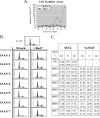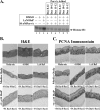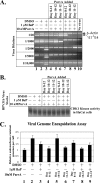Downregulation of Cdc2/CDK1 kinase activity induces the synthesis of noninfectious human papillomavirus type 31b virions in organotypic tissues exposed to benzo[a]pyrene
- PMID: 20181698
- PMCID: PMC2863740
- DOI: 10.1128/JVI.02431-09
Downregulation of Cdc2/CDK1 kinase activity induces the synthesis of noninfectious human papillomavirus type 31b virions in organotypic tissues exposed to benzo[a]pyrene
Abstract
Epidemiological studies suggest that human papillomavirus (HPV)-infected women who smoke face an increased risk for developing cervical cancer. We have previously reported that exposure of HPV-positive organotypic cultures to benzo[a]pyrene (BaP), a major carcinogen in cigarette smoke, resulted in enhanced viral titers. Since BaP is known to deregulate multiple pathways of cellular proliferation, enhanced virion synthesis could result from carcinogen/host cell interaction. Here, we report that BaP-mediated upregulation of virus synthesis is correlated to an altered balance between cell cycle-specific cyclin-dependent kinase (CDK) activity profile compared with controls. Specifically, BaP treatment increased accumulation of hyperphosphorylated retinoblastoma protein (pRb) which coincided with increased cdc2/CDK1 kinase activity, but which further conflicted with the simultaneous upregulation of CDK inhibitors p16(INK4) and p27(KIP1), which normally mediate pRb hypophosphorylation. In contrast, p21(WAF1) and p53 levels remained unchanged. Under these conditions, CDK6 and CDK2 kinase activities were decreased, whereas CDK4 kinase activity remained unchanged. The addition of purvalanol A, a specific inhibitor of CDK1 kinase, to BaP-treated cultures, resulted in the production of noninfectious HPV type 31b (HPV31b) particles. In contrast, infectivity of control virus was unaffected by purvalanol A treatment. BaP targeting of CDK1 occurred independently of HPV status, since BaP treatment also increased CDK1 activity in tissues derived from primary keratinocytes. Our data indicate that HPV31b virions synthesized in the presence of BaP were dependent on BaP-mediated alteration in CDK1 kinase activity for maintaining their infectivity.
Figures









Similar articles
-
The cigarette smoke carcinogen benzo[a]pyrene enhances human papillomavirus synthesis.J Virol. 2008 Jan;82(2):1053-8. doi: 10.1128/JVI.01813-07. Epub 2007 Nov 7. J Virol. 2008. PMID: 17989183 Free PMC article.
-
Adeno-associated virus type 2 increases proteosome-dependent degradation of p21WAF1 in a human papillomavirus type 31b-positive cervical carcinoma line.J Virol. 2006 May;80(10):4927-39. doi: 10.1128/JVI.80.10.4927-4939.2006. J Virol. 2006. PMID: 16641284 Free PMC article.
-
Treatment of a human papillomavirus type 31b-positive cell line with benzo[a]pyrene increases viral titer through activation of the Erk1/2 signaling pathway.J Virol. 2011 May;85(10):4982-92. doi: 10.1128/JVI.00133-11. Epub 2011 Mar 2. J Virol. 2011. PMID: 21367897 Free PMC article.
-
[Molecular mechanisms controlling the cell cycle: fundamental aspects and implications for oncology].Cancer Radiother. 2001 Apr;5(2):109-29. doi: 10.1016/s1278-3218(01)00087-7. Cancer Radiother. 2001. PMID: 11355576 Review. French.
-
Aberrant cell cycle regulation in cervical carcinoma.Yonsei Med J. 2005 Oct 31;46(5):597-613. doi: 10.3349/ymj.2005.46.5.597. Yonsei Med J. 2005. PMID: 16259056 Free PMC article. Review.
Cited by
-
Co-carcinogenesis: Human Papillomaviruses, Coal Tar Derivatives, and Squamous Cell Cervical Cancer.Front Microbiol. 2017 Nov 16;8:2253. doi: 10.3389/fmicb.2017.02253. eCollection 2017. Front Microbiol. 2017. PMID: 29180993 Free PMC article.
-
Adeno-associated virus type 2 infection of nude mouse human breast cancer xenograft induces necrotic death and inhibits tumor growth.Cancer Biol Ther. 2014 Aug;15(8):1013-28. doi: 10.4161/cbt.29172. Epub 2014 May 16. Cancer Biol Ther. 2014. PMID: 24834917 Free PMC article.
-
Tobacco exposure results in increased E6 and E7 oncogene expression, DNA damage and mutation rates in cells maintaining episomal human papillomavirus 16 genomes.Carcinogenesis. 2014 Oct;35(10):2373-81. doi: 10.1093/carcin/bgu156. Epub 2014 Jul 26. Carcinogenesis. 2014. PMID: 25064354 Free PMC article.
-
HPV and Cervical Cancer: A Review of Epidemiology and Screening Uptake in the UK.Pathogens. 2023 Feb 11;12(2):298. doi: 10.3390/pathogens12020298. Pathogens. 2023. PMID: 36839570 Free PMC article. Review.
-
Genome-Wide Profiling of Cervical RNA-Binding Proteins Identifies Human Papillomavirus Regulation of RNASEH2A Expression by Viral E7 and E2F1.mBio. 2019 Jan 29;10(1):e02687-18. doi: 10.1128/mBio.02687-18. mBio. 2019. PMID: 30696738 Free PMC article.
References
-
- Abelev, G. I. 2000. Differentiation mechanisms and malignancy. Biochemistry (Mosc.) 65:107-116. - PubMed
-
- Andrysik, Z., J. Vondracek, M. Machala, P. Krcmar, L. Svihalkova-Sindlerova, A. Kranz, C. Weiss, D. Faust, A. Kozubik, and C. Dietrich. 2007. The aryl hydrocarbon receptor-dependent deregulation of cell cycle control induced by polycyclic aromatic hydrocarbons in rat liver epithelial cells. Mutat. Res. 615:87-97. - PubMed
-
- Asselineau, D., and M. Prunieras. 1984. Reconstruction of ‘simplified’ skin: control of fabrication. Br. J. Dermatol. 111(Suppl. 27):219-222. - PubMed
Publication types
MeSH terms
Substances
Grants and funding
LinkOut - more resources
Full Text Sources
Research Materials
Miscellaneous

